If you’re running a growing eCommerce business in 2025, choosing the right platform is a big decision. Two of the most popular options for medium to large companies are BigCommerce vs Salesforce Commerce Cloud (SFCC).
This guide breaks down how these platforms compare across key areas, including:
- Pricing & total cost of ownership
- Core commerce features & customization
- B2B and B2C selling capabilities
- Architecture, headless & innovation
- Omnichannel and ecosystem integrations
- Support, onboarding & partner network
While both platforms offer advanced tools for B2C and B2B, they differ significantly in how they scale, how flexible they are, and what kind of businesses they’re best suited for.
Let’s continue reading with LitExtension to explore their strengths, limitations, and which platform fits your business best.
BigCommerce vs Salesforce Commerce Cloud: At a Glance
Platform type
BigCommerce is a SaaS (Software-as-a-Service) platform with an Open SaaS approach. This means it gives you a hosted, user-friendly backend but also lets you customize using APIs, headless frontends, and third-party tools.
In contrast, Salesforce Commerce Cloud is a tightly integrated enterprise cloud solution built around the Salesforce ecosystem. It offers built-in access to tools like Salesforce CRM and Marketing Cloud, but it’s more complex to set up and usually requires help from certified partners or agencies.
Where are BigCommerce and Salesforce Commerce Cloud heading?
eCommerce is entering a new era of growth and innovation, with global retail sales surpassing $4.1 trillion in 2024 and projected to reach $6.4 trillion by 2029 (Statista). As the industry scales, platforms like BigCommerce and Salesforce Commerce Cloud are evolving rapidly — but in very different ways.
On one hand, BigCommerce is leaning into openness, AI integration, and B2B growth. With tools like Catalyst, AR support, and headless flexibility, it’s becoming a go-to solution for mid-sized and enterprise merchants seeking scalability without enterprise bloat.
Meanwhile, Salesforce Commerce Cloud continues to expand within the Salesforce 360 ecosystem, emphasizing AI-driven personalization, omnichannel orchestration, and deep customer data unification through Einstein and CDP.
Personally, I think BigCommerce is a smart pick for businesses that value speed, flexibility, and modularity. At the same time, Salesforce Commerce Cloud shines for enterprises prioritizing scale, built-in AI, and unified customer data.
BigCommerce vs Salesforce Commerce Cloud: Key Differences at a Glance
| Category | BigCommerce | Salesforce Commerce Cloud | Verdict |
| Pricing & TCO | Subscription-based, predictable, lower upfront cost | GMV-based, higher at scale, deep value with Salesforce stack | BigCommerce |
| Core Commerce Cloud features & customization | Fast to launch, easier admin UI, strong customization for most teams | Flexible at scale, strong AI capabilities, more developer-heavy | BigCommerce (slight edge) |
| B2B and B2C capabilities | Strong native B2B suite, unified backend | Best-in-class B2C personalization, B2B is a separate product | Split: BigCommerce for B2B, SFCC for B2C |
| Architecture & innovation | Open SaaS, strong headless/startup-friendly, modular | Best for Salesforce-first teams, enterprise AI (Einstein), composable | Split: BigCommerce for openness, SFCC for AI & intelligence |
| Omnichannel & integrations | Built-in channels, flexible 3rd-party integration, quick to deploy | Centralized data via Salesforce 360, strong ecosystem value | Split: BigCommerce for channel agility, SFCC for data unification |
| Support & partner ecosystem | Fast onboarding, responsive support, inclusive docs/training | Long enterprise onboarding, high-tier support plans, advanced resources | BigCommerce (more accessible) |
Pricing & TCO (Total Cost of Ownership)
When evaluating an eCommerce platform, it’s important to understand how your total cost scales over time. From pricing models and usage thresholds to licensing, hidden fees, and return on investment, both BigCommerce and Salesforce Commerce Cloud take very different approaches.
In this section, we’ll break down their cost structures across four key areas:
- Pricing model: GMV-based vs fixed subscription tiers
- Scalability cost: How costs change as your sales grow
- Licensing and hidden fees: What’s included and what’s not
- ROI: Which platform delivers better value over time
Let’s take a closer look at how each platform performs across these cost-related dimensions.
Pricing model
BigCommerce uses a tiered subscription model based on your annual online sales.

The standard pricing tiers include:
- Standard: $39/month
- Plus: $105/month
- Pro: $399/month (up to $400k in annual sales; +$150/month per additional $200k)
- Enterprise: Custom pricing, typically starts around $400–$1,500+/month depending on features, support, and volume
But it’s worth noting that BigCommerce plans auto-upgrade based on annual online sales — meaning merchants cannot stay on lower tiers once revenue exceeds thresholds.
Meanwhile, Salesforce Commerce Cloud uses a GMV-based pricing model, meaning you pay a percentage of your gross merchandise volume. This typically ranges from 1% to 2% of your revenue, which means the more you sell, the more you pay.
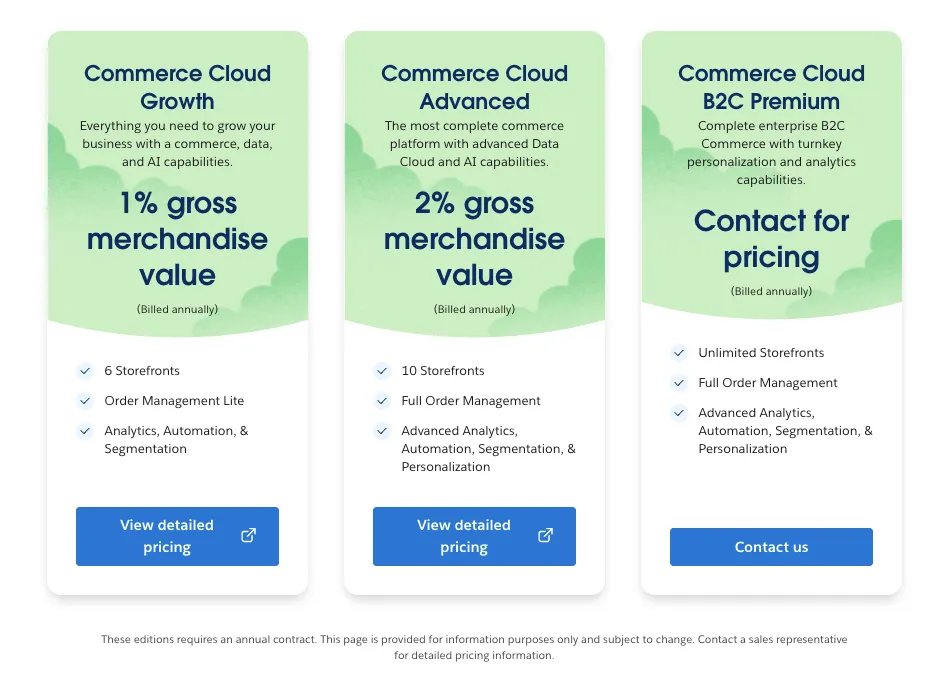
For example, a business making $5 million/year in online sales could pay:
- BigCommerce: Flat rate ~$1,200/month = ~$14,400/year
- Salesforce CC: At 2% GMV = $100,000/year
Winner: BigCommerce. For most businesses, especially those with high sales volume, BigCommerce offers predictable pricing and much lower long-term costs.
Enterprise costs & scalability
As your business grows, so do the BigCommerce vs Salesforce Commerce Cloud costs — but how those costs scale can make or break your long-term strategy. In this section, we’ll break down how these platforms handle enterprise growth from a pricing and scalability perspective.
| Criteria | BigCommerce | Salesforce Commerce Cloud |
| Scaling trigger | Auto-upgrades after $400K/year in sales on Pro Plan, +$150/month per additional $200K | Costs increase directly with revenue and additional Salesforce product usage |
| Custom pricing tier | Enterprise Plan (typically $400–$1,500+/mo), triggered above $1–$2M in annual sales | Fully custom from the start, based on GMV and stack configuration |
| Additional tool licensing | Optional — pricing rises modestly with apps and integrations | Additional licensing is often required for Marketing Cloud, Service Cloud, CDP, etc. |
| Example growth scenario | $5M/year → ~$14K/year → $20M/year → ~$25K/year | $5M/year → ~$100K/year → $20M/year → ~$400K/year (at 2% GMV) |
Winner: BigCommerce. Despite sales-based thresholds, BigCommerce still offers more predictable and cost-effective scaling. It lets you grow with flexibility and fewer long-term financial lock-ins than GMV-based pricing.
License, maintenance, and hidden fees
BigCommerce offers transparent licensing with no hidden platform fees, but it’s not entirely fee-free. While there are no transaction fees if you use a third-party payment provider (like Stripe or PayPal), you may pay additional fees for:
- Premium apps and integrations
- Design or headless front-end tools
- Exceeding sales thresholds (e.g, Pro plan limits)
Still, the core platform is fully hosted, secure, and stable, with predictable monthly costs.
In comparison, Salesforce Commerce Cloud often involves higher upfront implementation fees, longer contracts, and additional licensing for tools like:
- Marketing Cloud
- Service Cloud
- Salesforce B2B Commerce. It also charges GMV-based fees, and depending on your configuration, custom middleware may be needed to enable integrations — adding to the complexity and cost.
Winner: BigCommerce. It has fewer surprises, faster onboarding, and is less expensive to launch and maintain.
ROI and value at scale
BigCommerce delivers fast ROI for mid-sized businesses that want to launch quickly and scale without heavy technical overhead. While it does apply sales-based thresholds, pricing remains predictable, and ROI often arrives within the first year.
In contrast, Salesforce Commerce Cloud offers long-term value for large enterprises that need deep personalization, unified data, and cross-channel orchestration. However, that value depends on using tools like Salesforce CRM, CDP, and Marketing Cloud, which typically come with higher setup costs and longer ROI time.
That said, for Salesforce users, tools like Einstein AI, Salesforce CDP, and real-world insights from the Salesforce eCommerce data index provide a powerful lens into customer behavior, industry benchmarks, and scalable commerce performance.

Winner: Tie. BigCommerce wins for fast-growing, cost-conscious brands, while Salesforce Commerce Cloud wins for large enterprises using the full Salesforce ecosystem.
Final verdict for Pricing & TCO: BigCommerce is the clear winner in terms of affordability, predictability, and total cost — especially for businesses focused on growth and flexibility.
Core Commerce Features & Customization
Beyond pricing, the true power of any eCommerce platform lies in its features and how easily those features can be customized to fit your business. In this section, we’ll explore how BigCommerce and Salesforce Commerce Cloud compare across:
- Product management: Catalog scale, export structure, and ease of editing
- Checkout & payment: Flexibility, global readiness, and AI personalization
- Storefront customization: Theme variety, page builders, and developer frameworks
- Performance & hosting: Reliability, scalability, and infrastructure control
Let’s dive into how each platform supports your store’s operational core.
Product management
BigCommerce supports complex product catalogs with variants, custom fields, digital products, and bulk editing. You can manage up to 600 SKUs per product, and it supports multi-location inventory.
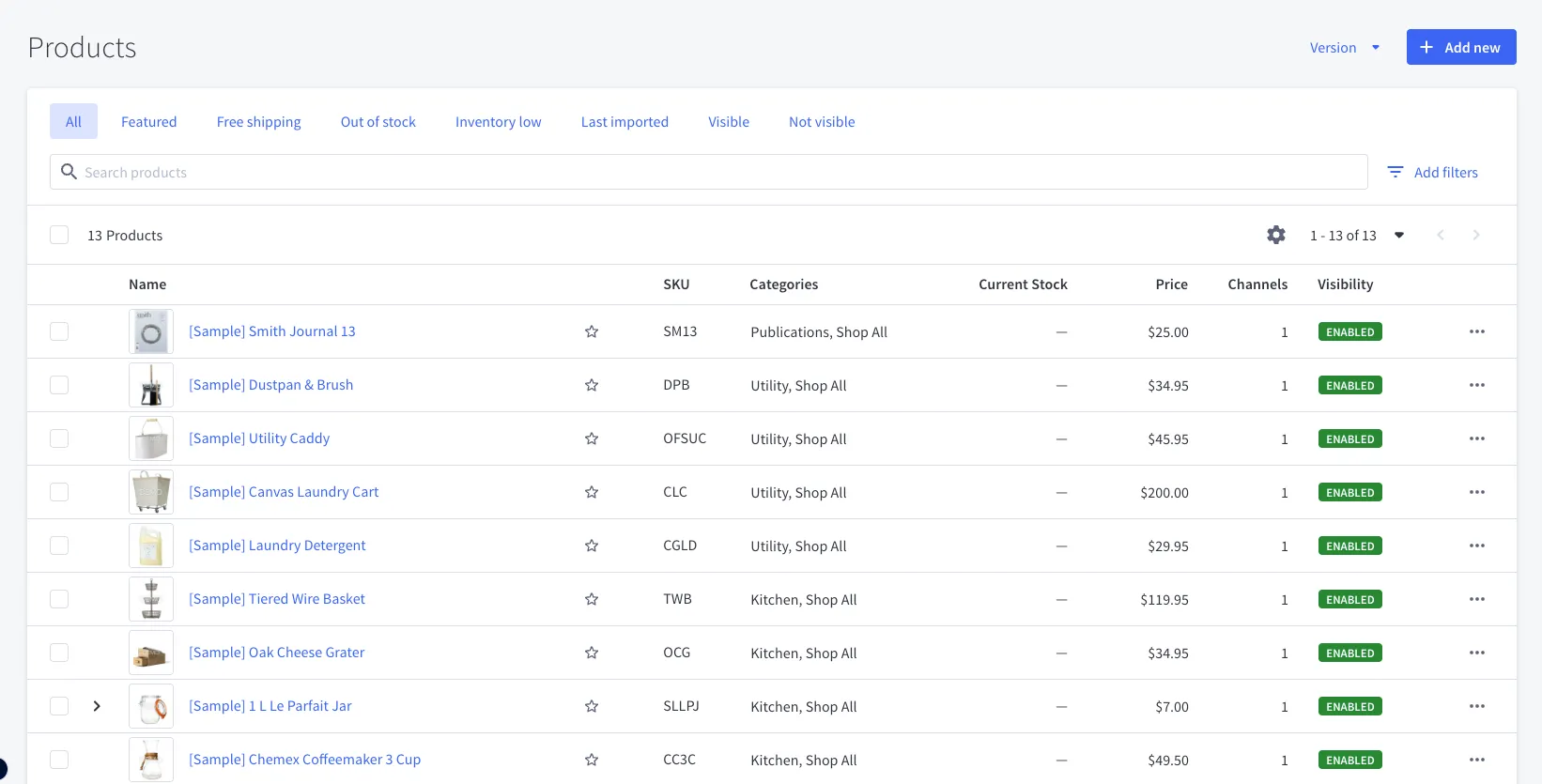
One standout advantage is its clean, well-structured CSV export format, which makes it easier for teams to edit, migrate, or sync product data across systems without cleanup.
Salesforce Commerce Cloud also handles large catalogs well. It’s built for enterprise retailers with thousands of SKUs, localized catalogs, and dynamic pricing.
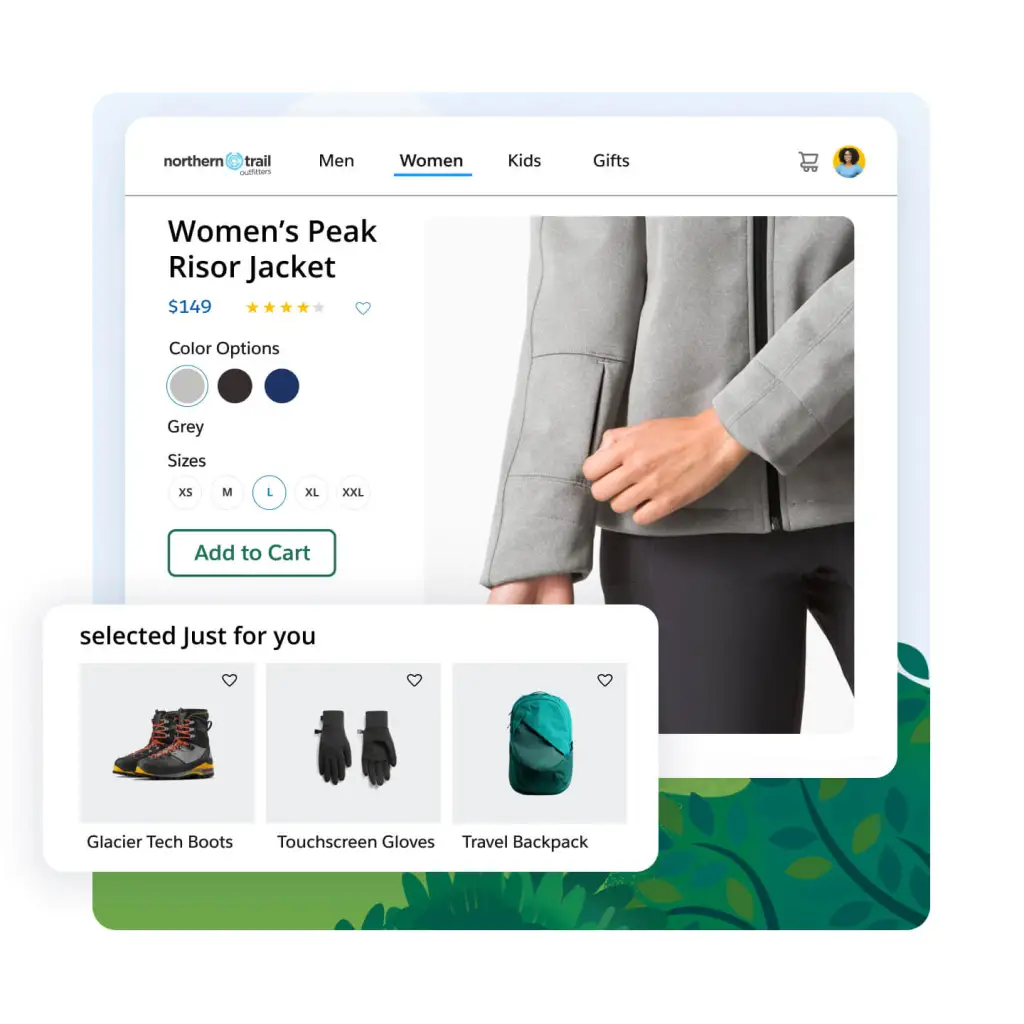
In addition to advanced AI-powered merchandising (like Einstein recommendations shown above), SFCC allows for deep product configuration. However, product data exports are often more complex, requiring customization or partner tools to format and work with efficiently — especially for stores using custom attributes or localized catalogs.
For a fast-moving team updating product info weekly, BigCommerce’s CSV exports and admin tools are much more straightforward. Salesforce supports the same scale but usually needs developer help to manage it efficiently.
Winner: Tie. Both BigCommerce vs Salesforce Commerce Cloud are strong here. BigCommerce is more user-friendly; Salesforce is more flexible at scale.
Checkout & payment options
BigCommerce offers a customizable checkout, supports multi-currency, and integrates easily with 100+ payment gateways like Stripe, PayPal, Adyen, and Authorize.Net. One-page checkout is built-in, and headless checkout options are also supported.
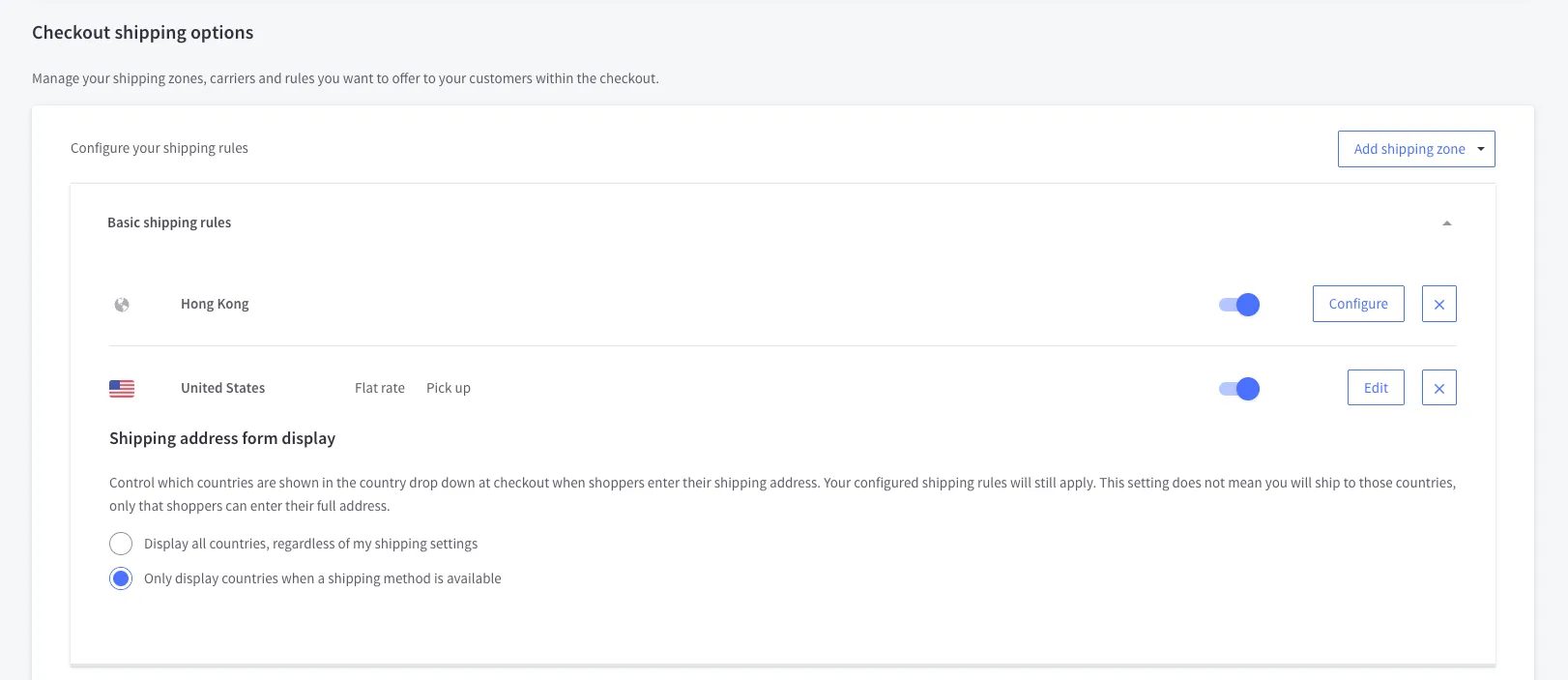
In comparison, Salesforce Commerce Cloud uses a more controlled checkout flow, often requiring developers to build and customize. But it shines when paired with Einstein AI, which can personalize the experience based on customer behavior.
For example, a fast-growing D2C brand may want to quickly A/B test checkout layouts — easier in BigCommerce. Meanwhile, a global fashion giant can use Salesforce to deliver AI-powered recommendations and currency-based pricing at checkout.
Winner: Tie. BigCommerce is faster to deploy and test. Salesforce wins if you need AI personalization and global checkout logic.
Storefront customization & themes
BigCommerce offers a flexible balance between no-code tools and developer-level control. You can use the drag-and-drop Page Builder for simple layout changes or dive into the Stencil framework for full theme customization.

There are over 200+ responsive themes available on the BigCommerce Theme Marketplace (both free and paid), covering a wide range of industries and styles. Additionally, developers can build custom storefronts using popular headless frameworks like Next.js or React.
Recently, BigCommerce launched Catalyst, an enterprise-focused initiative that redefines what's possible in storefront customization. Catalyst includes a modern, developer-friendly front-end framework designed to support fully tailored user experiences — whether you're building a headless storefront or using native BigCommerce tools.
Meanwhile, Salesforce Commerce Cloud uses the Storefront Reference Architecture (SFRA), which is powerful but developer-heavy. While SFRA gives full control over layout and logic, it doesn’t come with a large public theme marketplace. Instead, most SFCC storefronts are built from scratch or customized via agency-built templates.
Winner: BigCommerce. More accessible customization options for most teams. Salesforce is powerful but resource-intensive.
Performance & hosting
BigCommerce is fully hosted on Google Cloud with built-in CDN, fast page loads, and 99.99% uptime SLA. Performance is optimized by default, and you don’t need to manage servers.
Salesforce Commerce Cloud is also highly reliable and built for enterprise-grade traffic, including seasonal spikes like Black Friday. But due to its architecture, actual performance depends more on your custom implementation.
For stores with international traffic and lots of product data, both platforms perform well. But BigCommerce offers strong performance with less technical setup.
Winner: Tie. Both provide fast, reliable performance: BigCommerce with simplicity and Salesforce with customization.
Final verdict on Core Commerce features: BigCommerce has a slight win when it gives growing businesses a faster path to launch, test, and iterate with fewer technical hurdles.
B2B and B2C Commerce Capabilities
Whether you're selling to businesses, consumers, or both, your eCommerce platform needs to support complex workflows, personalized experiences, and scalable architecture.
In this section, we compare how each platform handles:
- B2B commerce: Quoting, custom pricing, buyer roles, and procurement tools
- B2C commerce: Personalization, segmentation, localization, and merchandising
Let’s get in.
BigCommerce vs Salesforce Commerce Cloud B2B features
BigCommerce includes B2B Edition, a native suite designed for manufacturers, wholesalers, and distributors.
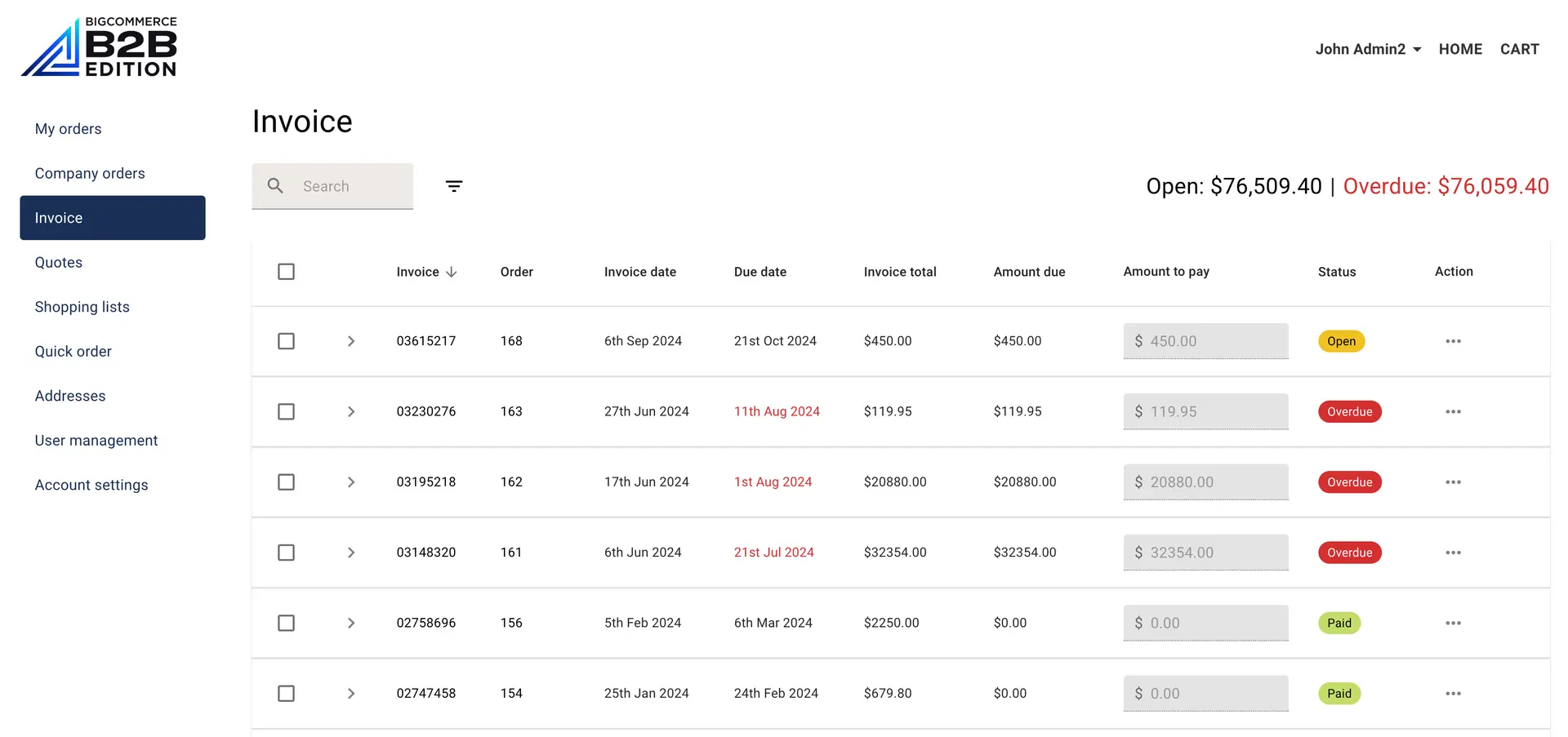
It offers:
- Company accounts with multiple buyers
- Custom pricing by customer group
- Volume discounts
- Quote management
- Purchase orders and net payment terms
- Punchout catalog support (for enterprise procurement systems)
Meanwhile, SFCC provides Salesforce B2B Commerce (on Lightning Experience) as a separate product from its B2C offering.
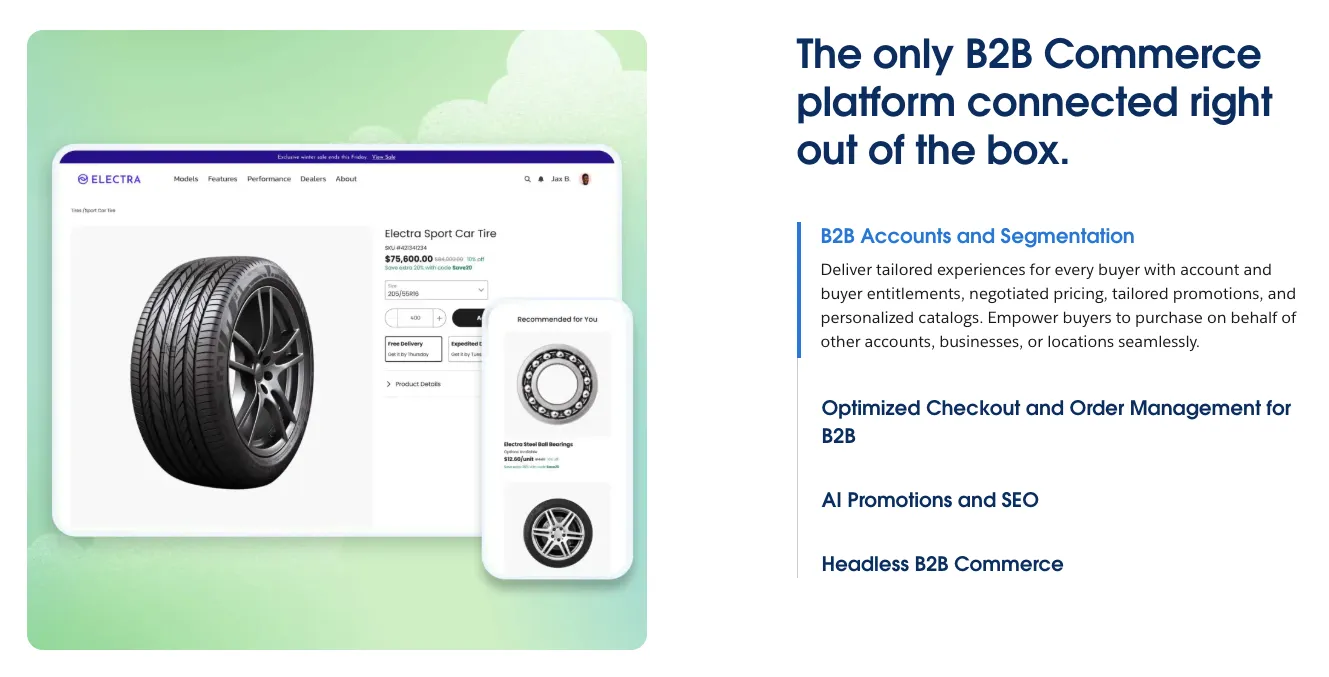
It includes:
- Buyer-specific catalogs and pricing
- Self-service portals
- Reordering, bulk ordering, and contract pricing
- Native integration with Salesforce CPQ (Configure, Price, Quote)
Let’s say a B2B electronics wholesaler needs custom price lists, team-based buyers, and PO workflows. BigCommerce B2B Edition has it right away. Salesforce can do all that as well, but it usually requires a deeper Salesforce setup and implementation.
Winner: BigCommerce. For most businesses, BigCommerce B2B is easier to use and faster to deploy. Salesforce offers deep integration with Salesforce’s broader B2B tools but at a higher cost and complexity.
BigCommerce vs Salesforce Commerce Cloud B2C features
BigCommerce supports standard B2C features like product reviews, customer groups, promotional pricing, wishlists, and loyalty programs (via apps). Personalization and AI tools are available via third-party integrations.
By contrast, Salesforce Commerce Cloud is heavily geared toward B2C, especially for global retailers. It includes:
- Industry-leading Composable Storefront
- AI-powered personal shopper
- Merchandising tools
- Connected commerce and marketing with a 360-degree view of your customers without having to piece together different solutions

Let’s have a small example. A luxury apparel brand with localized storefronts across five countries will benefit from Salesforce’s built-in support for translation, tax rules, and AI-driven merchandising. Meanwhile, a mid-size cosmetics brand scaling into new regions may find BigCommerce faster to launch and customize.
Winner: Salesforce Commerce Cloud. This platform offers more built-in tools for personalization, targeting, and enterprise-level merchandising. BigCommerce can get there with add-ons, but it’s not as native.
Final verdict on B2B & B2C commerce capabilities: It really depends. BigCommerce is better if B2B selling is a core part of your business and you want a quicker, cost-effective setup. SFCC is better if you’re a large B2C brand that needs AI-driven personalization, segmentation, and localization at scale.
Architecture & Headless & Innovation Capabilities
Modern eCommerce demands flexibility, composability, and intelligent automation. In this section, we’ll evaluate how BigCommerce and Salesforce Commerce Cloud support:
- Headless commerce and modern front-end frameworks
- Composable architecture and extensibility across tech stacks
- AI, automation, and real-time personalization
Let’s explore how future-ready each platform truly is.
Headless capabilities & frameworks
Both platforms support headless commerce, but the setup experience differs significantly.
BigCommerce supports headless commerce out of the box.

It offers:
- REST & GraphQL APIs
- SDKs for popular frameworks like Next.js, Gatsby, Vue.js
- Pre-built starter kits and support for frontends like Contentful, WordPress, Sanity.io
- A headless storefront called BigCommerce for WordPress and integrations with Shogun Frontend, Vue Storefront, and more
Salesforce Commerce Cloud also supports headless commerce, mainly through:
- Storefront Reference Architecture (SFRA) — a framework for custom frontend development
- Newer options like Composable Storefront (built on React)
- Powerful backend APIs, but requires Salesforce dev expertise and implementation partners
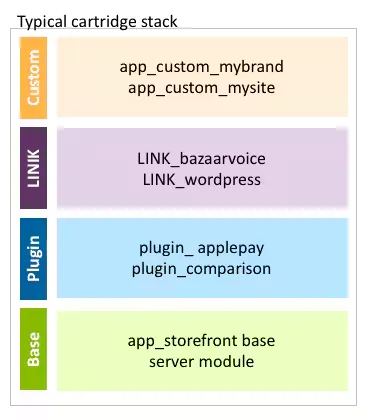
If you want to build a custom React storefront and plug it into your existing CMS, BigCommerce offers a quicker, easier start with modern tools. Salesforce can do it too, but typically, it requires more custom work and overhead.
Winner: BigCommerce. This platform is more accessible for most teams, especially those new to headless.
Composable architecture & platform extensibility
BigCommerce embraces composability through its Open SaaS model:
- Seamless integration with ERPs, PIMs, CRMs, and third-party tools
- Flexible microservices architecture with swappable tools like Algolia (search), Klaviyo (marketing), or NetSuite (ERP)
- Robust ecosystem and open APIs for almost every function
Salesforce Commerce Cloud is also composable but more focused on the Salesforce ecosystem:
- Deep integration with Salesforce CDP, Service Cloud, and Marketing Cloud
- Less open to third-party systems (integration possible, but often requires middleware or Salesforce developers)
- Powerful if you’re all-in on Salesforce, less flexible if you’re not
A company using Microsoft Dynamics ERP and HubSpot for CRM may find BigCommerce more plug-and-play. Meanwhile, a business that’s already running a Salesforce stack will benefit from tighter integration within Commerce Cloud.
Winner: Actually, it’s hard to define the winner here. BigCommerce is more open and flexible across tech stacks, while Salesforce is best if you’ve standardized on Salesforce products.
AI, automation, and real-time personalization
BigCommerce does not have built-in AI, but you can integrate it with:
- Third-party AI tools like Bloomreach, Segment, Spresso.AI, or Klevu AI Search & Merchandising
- Automated marketing apps like Klaviyo or Mailchimp
- Simple rule-based personalization through customer groups and discounts
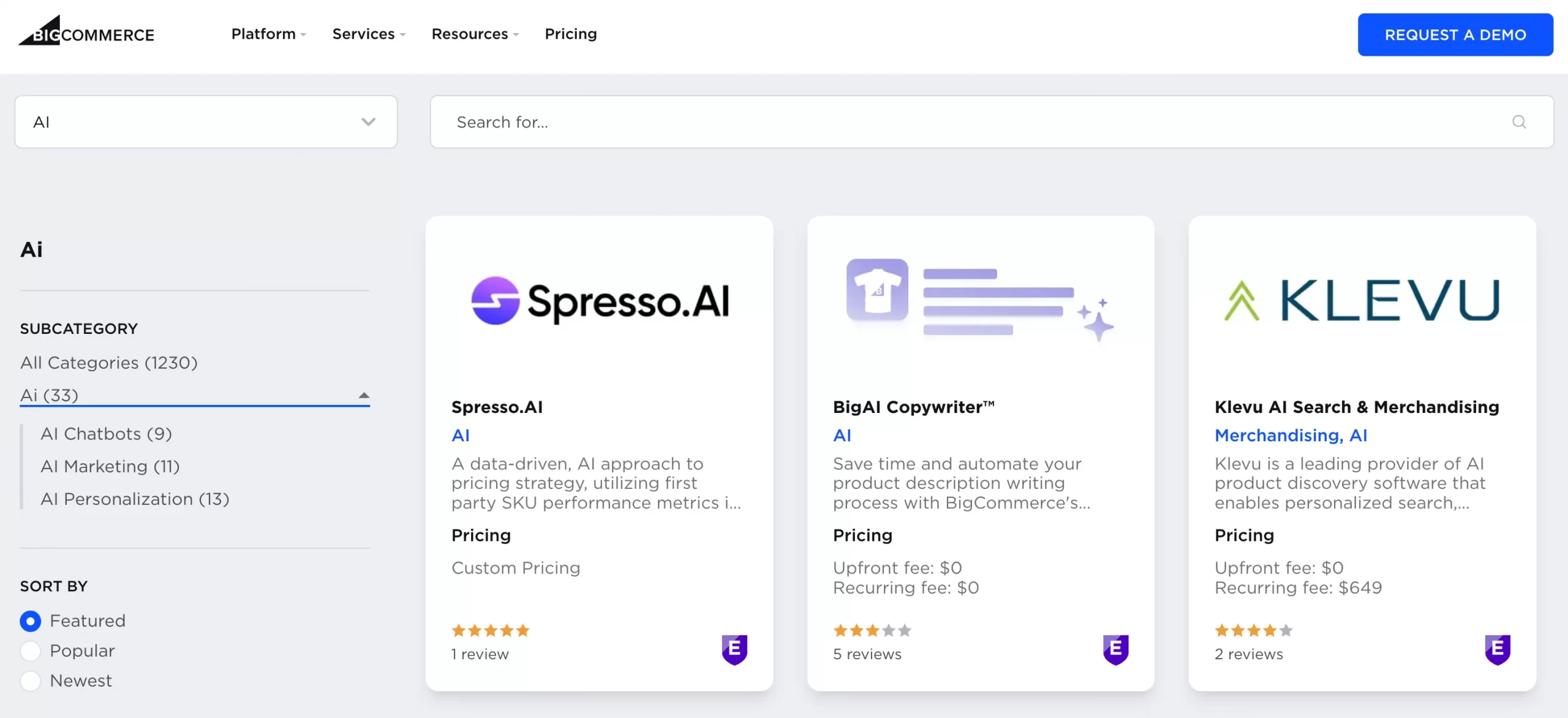
This gives merchants the freedom to choose their own tech stack, but it also means managing multiple tools, handling data sync manually, and potentially paying extra for features that Salesforce includes natively.
In comparison, Salesforce Commerce Cloud includes native Einstein AI, offering:
- Real-time product recommendations
- Personalized search results
- Predictive sort, merchandising, and abandoned cart recovery
- AI-powered insights across the customer journey
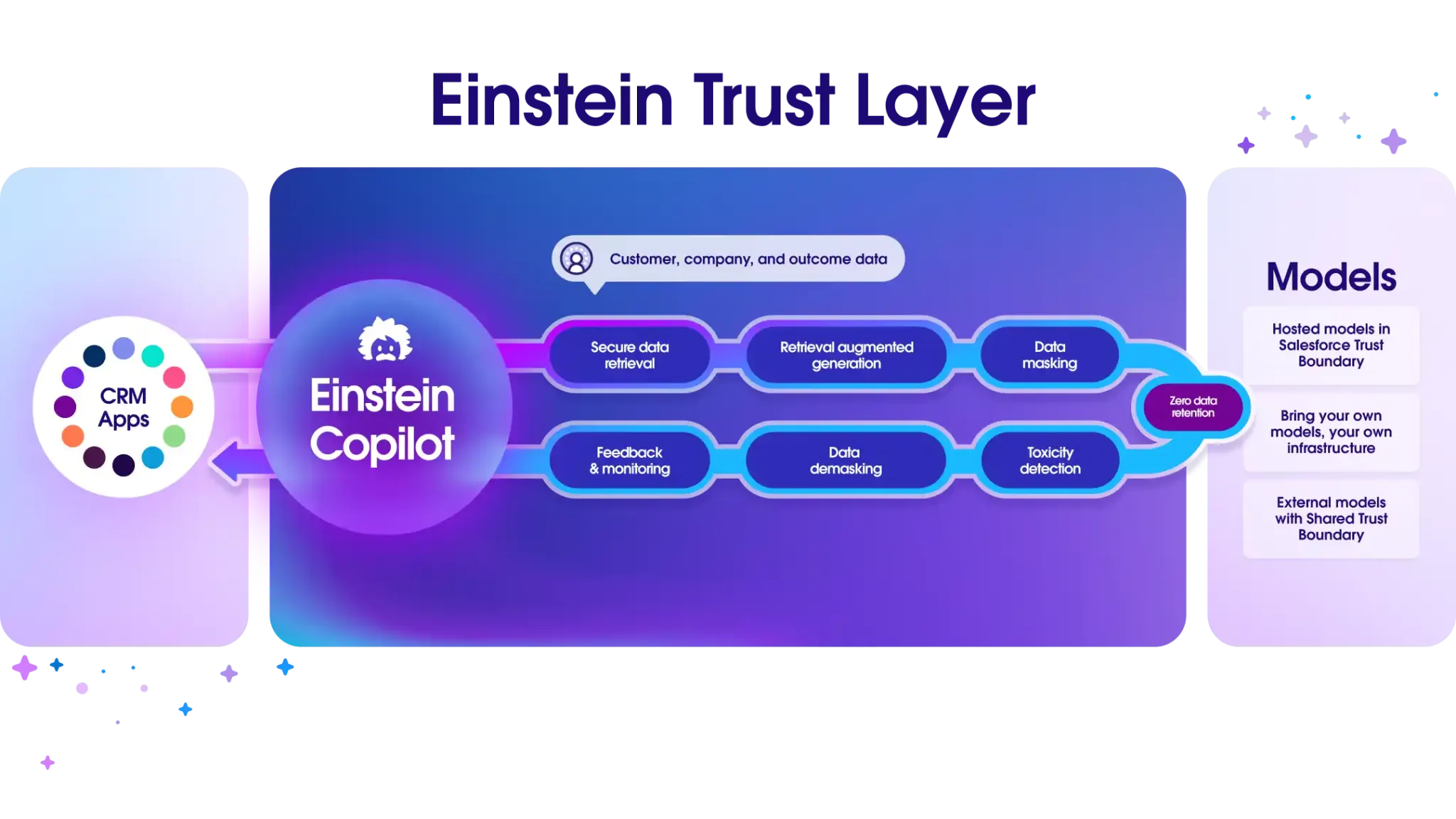
As you can see, everything runs on centralized customer data, enabling SFCC to offer cohesive, behavior-driven experiences out of the box. There's no need to connect multiple apps or worry about inconsistent data — Einstein does it all natively, with minimal configuration.
Winner: Salesforce Commerce Cloud. AI and automation are deeply embedded in the platform.
Final verdict on platform architectures: BigCommerce is a bit more flexible, easier to extend, and more accessible for teams building modern, composable eCommerce stacks.
Omnichannel Commerce & Integrations
Customers now shop across platforms — from Instagram and Amazon to mobile apps and in-store kiosks. To meet them where they are, your eCommerce platform must offer seamless integrations with sales channels, CRMs, ERPs, and more.
In this section, we’ll compare:
- Channel management: Native integrations with marketplaces and social channels
- CRM & ERP integrations: Connecting backend systems
- Ecosystem alignment: Salesforce 360 vs third-party openness
Let’s explore how BigCommerce and Salesforce Commerce Cloud connect to the broader commerce ecosystem.
Channel management (Amazon, Meta, eBay, etc.)
BigCommerce offers built-in integrations with:
- Amazon, eBay, Walmart, Meta (Facebook/Instagram), and TikTok
- Google Shopping + Buy on Google
- Omnichannel app partners like Feedonomics or CedCommerce, etc.
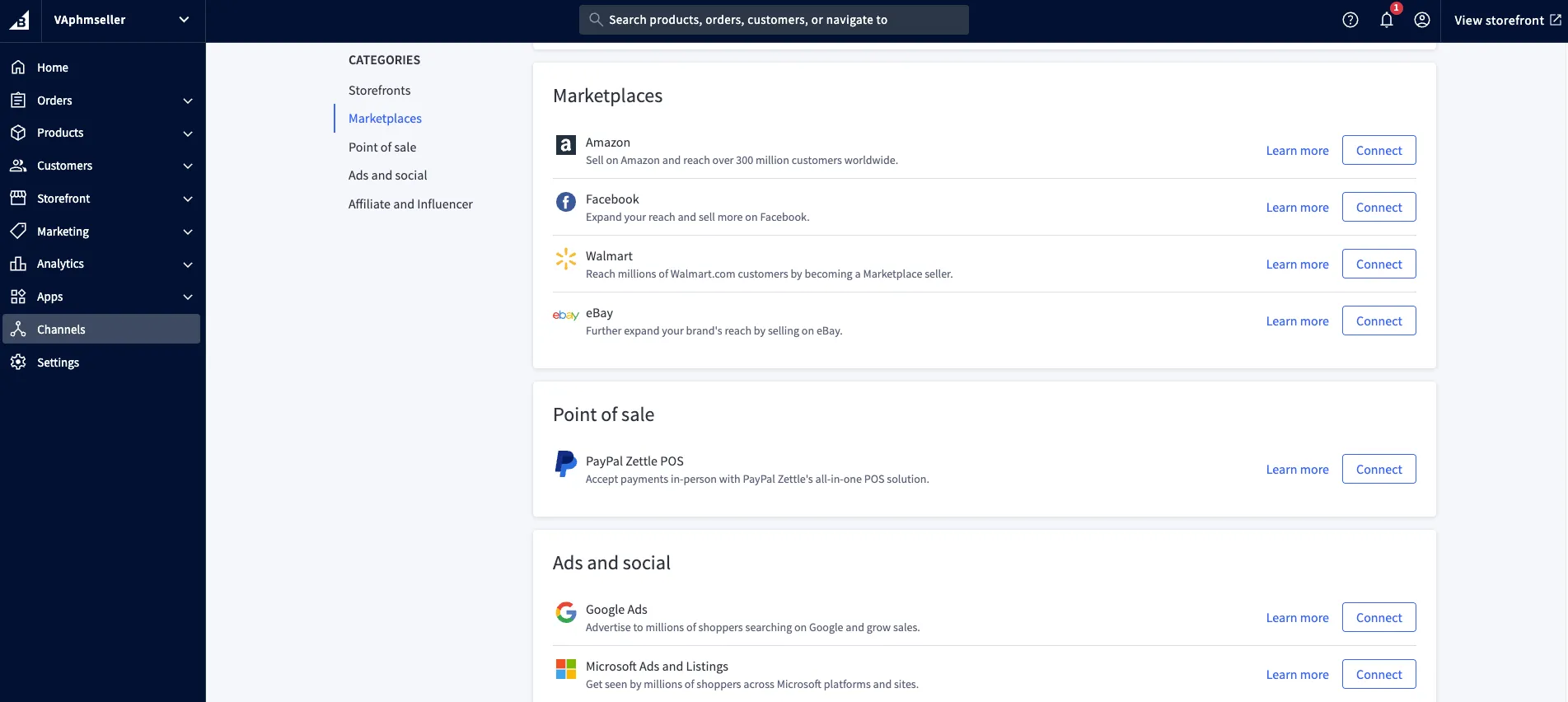
Channel management is handled through the control panel or third-party apps, making it accessible to non-technical users.
Meanwhile, Salesforce Commerce Cloud supports omnichannel selling, but it doesn’t offer built-in, one-click integrations with channels like Amazon or Instagram. Instead, you’ll usually need custom development or a Salesforce partner to connect those platforms.
That said, Salesforce is strong at managing the overall customer experience across channels, thanks to its deep integration with tools like Marketing Cloud, CDP, and CRM. So, while it’s not as simple to set up, it’s powerful for brands that want full control of their omnichannel strategy.
If you want to sync inventory with Amazon and list on TikTok without hiring a developer, BigCommerce gets you there faster. Salesforce can do it, but usually through middleware or a partner solution.
Winner: BigCommerce. More built-in options and easier to manage for direct-to-consumer brands selling across multiple channels.
CRM & ERP integrations
When it comes to connecting your eCommerce platform with backend systems like ERPs and CRMs, both BigCommerce and Salesforce Commerce Cloud offer robust options — but their philosophies differ.
BigCommerce follows an open approach. It integrates smoothly with popular ERP systems like Microsoft Dynamics, NetSuite, and SAP Business One, along with CRMs such as HubSpot, Zoho, and even Salesforce CRM. Most of these connections are enabled via pre-built apps, native APIs, or middleware platforms like Celigo or Tray.io — making integration fast and cost-effective, especially for businesses that aren’t tied to a single ecosystem.
In contrast, Salesforce Commerce Cloud is built to shine within its own ecosystem. Integration with Salesforce CRM, Service Cloud, Marketing Cloud, and CDP is seamless and powerful, enabling unified customer data across sales, service, and marketing.

However, when businesses want to connect external ERPs or CRMs, the process is usually more complex, often requiring custom development or middleware like MuleSoft.
So, while BigCommerce gives you the freedom to build your own stack with plug-and-play efficiency, Salesforce Commerce Cloud rewards you only if you're fully invested in the Salesforce ecosystem.
Winner: Tie. BigCommerce is more flexible with third-party tools. Salesforce is unbeatable if you're already invested in the Salesforce ecosystem.
Salesforce 360 integration vs 3rd-party ecosystem
Salesforce Commerce Cloud is part of Salesforce 360, which unifies sales, marketing, service, and commerce, real-time customer profiles, cross-channel campaign tracking, and AI-powered insights across the funnel.
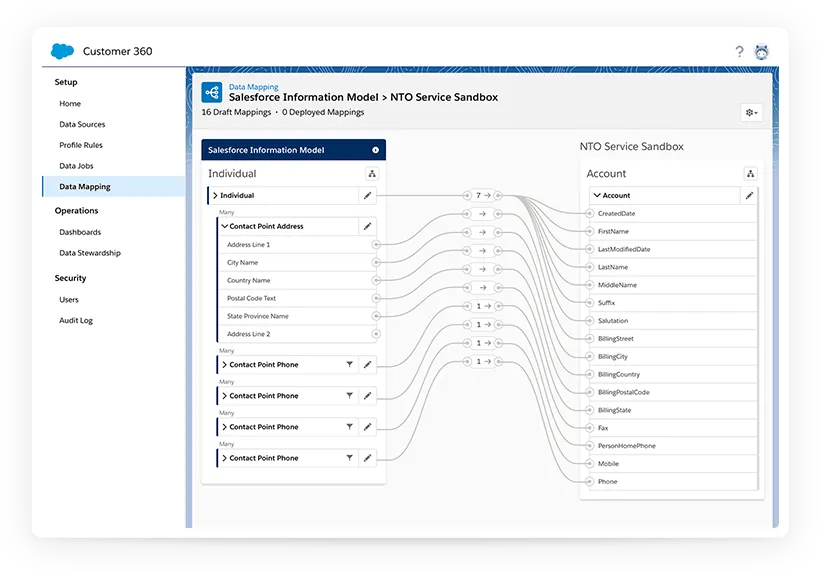
BigCommerce does not have a native ecosystem like Salesforce 360. Instead, it embraces a modular, best-of-breed approach where you can pick and integrate whichever CMS, CDP, or analytics tool fits your business. It’s more open but less centralized.
If you're looking for a single source of truth for your customer data, Salesforce Commerce Cloud offers that through 360. If you're building a custom stack (eg., Segment + Klaviyo + Zendesk), BigCommerce is more flexible.
Winner: Salesforce Commerce Cloud. It’s built for centralized customer intelligence and works best when you’re already using multiple Salesforce products.
Final verdict on omnichannel commerce: Again, it depends. BigCommerce is ideal if you want fast, flexible integrations with a variety of third-party tools and sales channels. Meanwhile, Salesforce Commerce Cloud is stronger if you’re fully committed to the Salesforce ecosystem and need deep, unified data capabilities.
Support & Partner Ecosystem
Launching and scaling an enterprise eCommerce store takes more than just features — it also depends on how easily you can get help, how deep the partner network goes, and what kind of training or onboarding is available to your team. Here’s how BigCommerce and Salesforce Commerce Cloud compare.
Onboarding experience
BigCommerce offers faster onboarding through in-house Enterprise Launch Services (optional) or a network of certified agencies and solution architects. Also, BigCommerce users can easily access self-service features, which makes it possible to launch stores in weeks rather than months.

Onboarding complexity depends on integrations and design, but overall time-to-launch is shorter compared to Salesforce.
Salesforce Commerce Cloud onboarding is more complex and typically requires certified implementation partners or agencies, significant scoping and planning, and integration with multiple Salesforce products (CRM, Marketing Cloud, etc.). As a result, projects on SFCC often take 3–6+ months to launch, depending on the scope and level of customization required.
For example, a mid-size brand switching platforms can go live with BigCommerce in under 2 months. Salesforce might take 4–6 months and require a partner like Deloitte, Publicis Sapient, or Wunderman Thompson.
Winner: BigCommerce. It has faster, more accessible onboarding for most teams — even without in-house developers.
Support tiers and SLAs
BigCommerce offers inclusive and accessible support, with:
- 24/7 live chat, phone, and ticket support
- Dedicated Account Manager for enterprise clients
- Priority support available with enterprise SLAs
This structure ensures that even fast-scaling businesses get timely help without needing to negotiate costly add-ons.
Salesforce Commerce Cloud, by contrast, support depends on your contract level and may include:
- Access to Salesforce Premier or Signature Success Plans
- A named Success Manager and 24/7 critical issue support
- Service response times vary by tier, with top-tier plans offering fast SLAs but at a premium
However, this level of service typically comes at a significant premium and often requires a defined escalation plan to access high-priority support.
For instance, BigCommerce Enterprise users can often speak directly to engineers and get same-day resolutions, whereas Salesforce clients may need to go through formal processes or pay extra to unlock the same level of responsiveness.
Winner: BigCommerce. BigCommerce has more responsive and inclusive support options, while Salesforce’s best support comes at a higher cost.
Documentation & training resources
Both platforms provide strong documentation and learning paths, but they serve different types of users.
BigCommerce shines when it comes to accessibility and practicality. Its Help Center offers clear technical docs and API references, and its BigCommerce University is tailored to merchants, marketers, and developers. From live webinars to active community forums, the platform prioritizes education for users of all backgrounds — not just engineers.
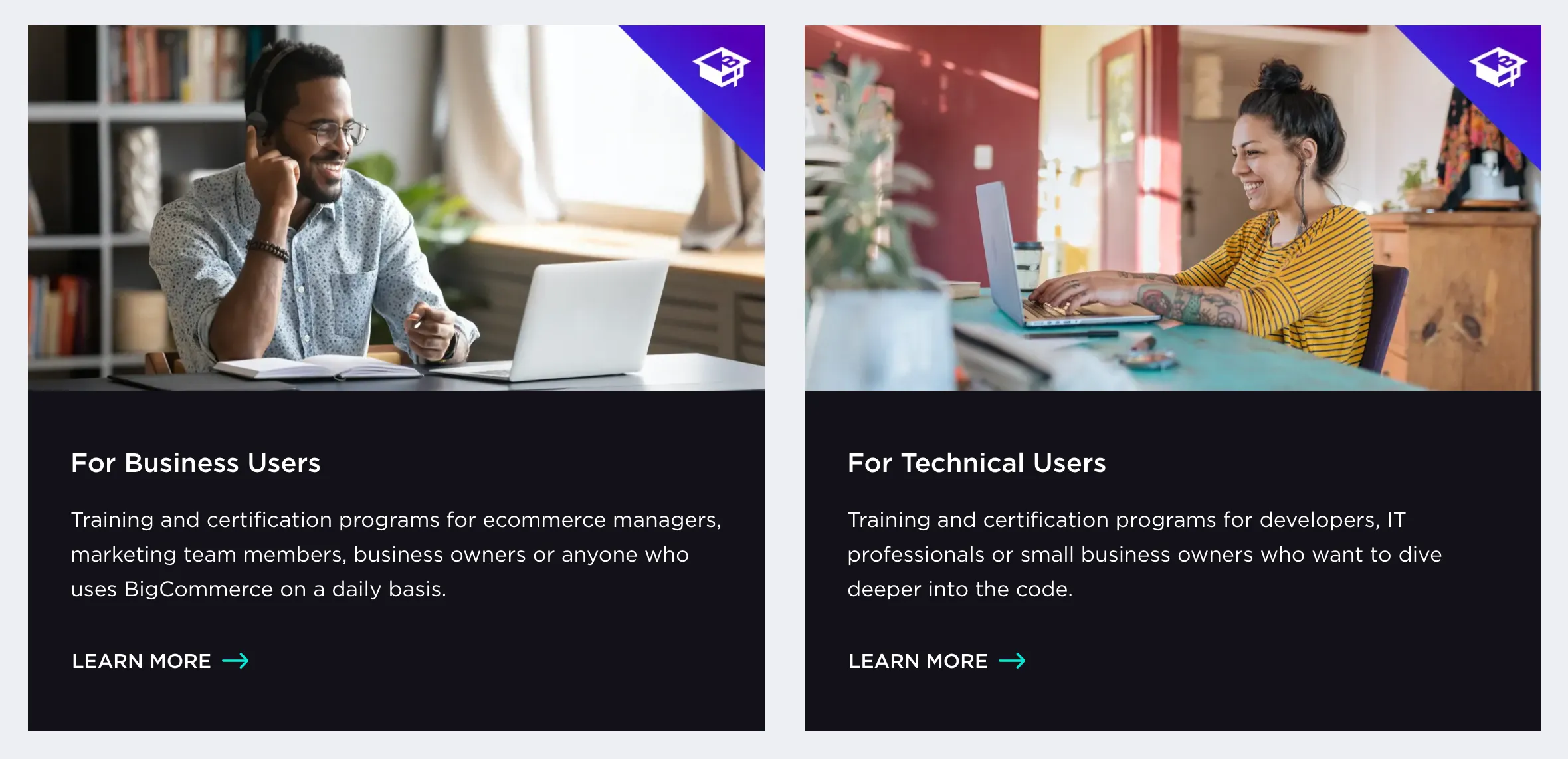
Salesforce Commerce Cloud, meanwhile, offers deep, structured training through its renowned Trailhead platform. This includes learning paths, certifications, and partner training that are ideal for teams with dedicated Salesforce developers or admins.

While the content is extensive and enterprise-grade, it assumes a level of Salesforce familiarity and commitment that may not suit every business.
Winner: Tie. Both platforms provide excellent resources. BigCommerce is easier for general teams to access. Salesforce Trailhead is deeper for those invested in the ecosystem.
Final verdict on support: BigCommerce wins for its fast onboarding, inclusive support, and easy-to-understand resources.
Who is BigCommerce and Salesforce Commerce Cloud Built for?
Now that we've compared both platforms across key dimensions — from pricing and customization to integrations, AI, and support — it's time to bring it all together. Which platform actually fits your business best? Let’s break it down based on your company size, tech resources, and strategic goals.
BigCommerce is best for you if…
- You’re a mid-sized to large business that wants enterprise features without enterprise bloat.
- You want to launch quickly, customize easily, and scale without breaking your budget.
- Your team values API flexibility and prefers an open approach to building a tech stack (with tools like Klaviyo, HubSpot, NetSuite, etc.).
- You need to manage both B2B and B2C in one streamlined platform.
- You want to test headless or composable commerce without heavy dev work.
Examples: Scaling D2C brands, manufacturers expanding into online B2B, retailers launching global storefronts with limited in-house tech teams.
Salesforce Commerce Cloud is best for you if…
- You’re a large enterprise with a dedicated IT team or agency support.
- You’re already using other Salesforce products (Sales Cloud, Marketing Cloud, Service Cloud) and want full ecosystem integration.
- You need deep personalization with AI, customer segmentation, and predictive merchandising.
- You’re operating globally and need advanced multi-store, multi-language, and multi-currency management.
Examples: Global fashion brands, luxury retailers, consumer electronics giants, or multi-national B2C brands heavily invested in Salesforce 360.
Are you ready to make the move? Let LitExtension help!
Migrating from or to a new eCommerce platform is a big step — and it shouldn’t be done alone.
👉 Perform BigCommerce migration with LitExtension. Our BigCommerce migration experts will help you move your data, products, customers, and orders quickly and securely with no downtime.
👉 Perform Salesforce Commerce Cloud migration with LitExtension. LitExtension provides end-to-end data SFCC migration tailored for enterprise businesses with complex structures and large catalogs.
Let our team handle the heavy lifting while you focus on growing your business.
BigCommerce vs Salesforce Commerce Cloud: FAQs
What is better than BigCommerce?
It depends on your business goals. BigCommerce is a great choice for flexibility, lower costs, and fast setup — especially for growing businesses. However, some brands may prefer: Salesforce Commerce Cloud for enterprise-grade AI and CRM integration, Shopify Plus for ease of use and large app ecosystem or Adobe Commerce (Magento) for fully custom, self-hosted builds
Does BigCommerce integrate with Salesforce?
Yes. BigCommerce integrates with Salesforce CRM and other Salesforce tools through native apps (like Zapier and HubSpot-Salesforce bridges), middleware platforms (like Celigo or MuleSoft), and custom API integrations using BigCommerce’s open API and Salesforce’s developer tools.
What is the difference between Salesforce Sales Cloud and Commerce Cloud?
Salesforce Sales Cloud and Commerce Cloud are two separate Salesforce products with different purposes. Salesforce Sales Cloud is a CRM (Customer Relationship Management) tool for managing leads, accounts, sales reps, and pipelines. Salesforce Commerce Cloud is an eCommerce platform for managing online storefronts, product catalogs, shopping carts, and orders.
Final Words
As you may see, both BigCommerce vs Salesforce Commerce Cloud are powerful eCommerce platforms.
BigCommerce is the clear winner when it comes to flexibility, ease of use, and total cost of ownership. It’s ideal for fast-scaling businesses that want control over their tech stack and a quicker time-to-market.
Salesforce Commerce Cloud, on the other hand, is a strong fit for large enterprises already using Salesforce tools — especially those looking to centralize data, use AI personalization, and manage global B2C operations at scale.
We hope you found this article insightful and now have a clear understanding of the differences between BigCommerce and Salesforce Commerce Cloud. For more content like this, be sure to visit the LitExtension blog and join our eCommerce community to gain further insights and connect with fellow business owners.

